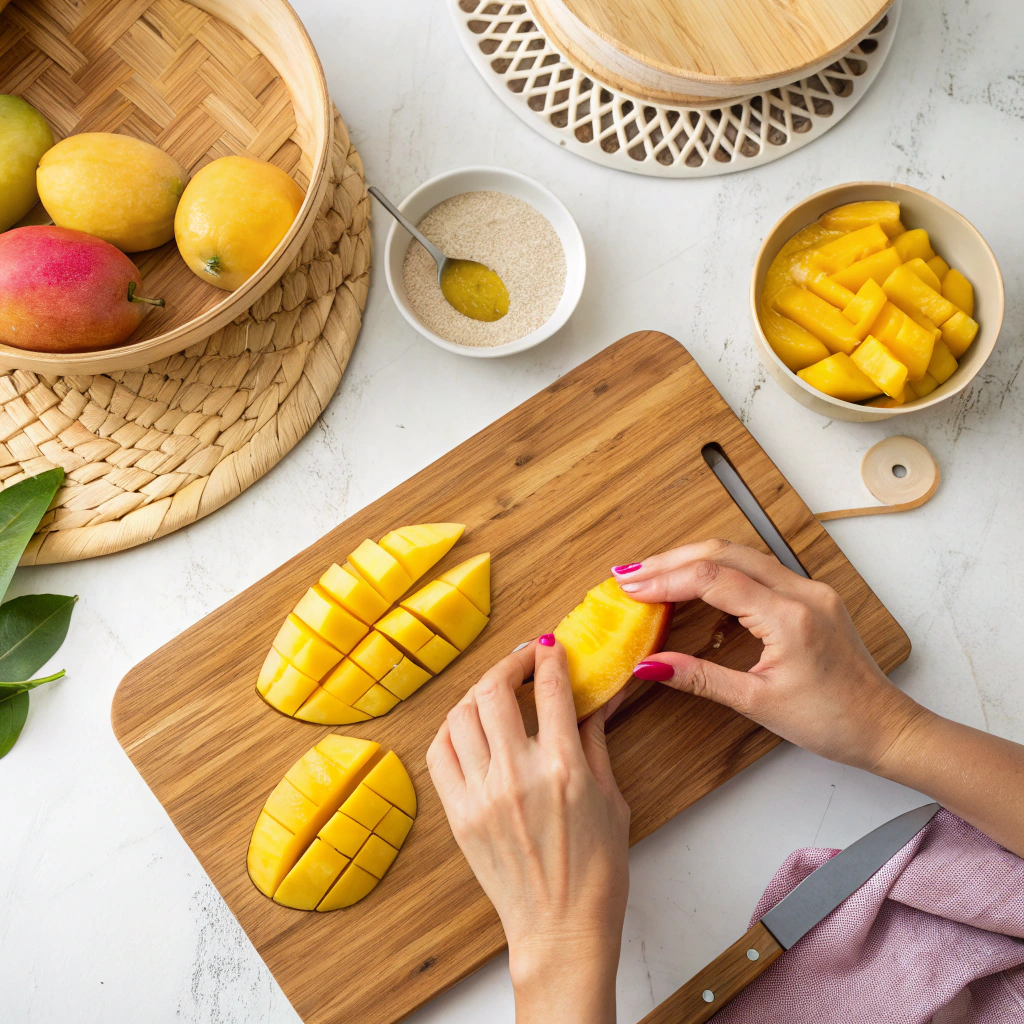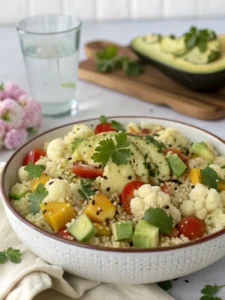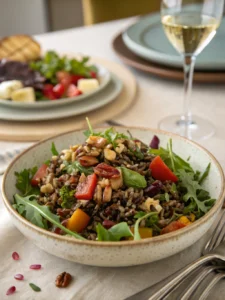Introduction:
Did you know you can enjoy the sweet, creamy flavors of Thai sticky rice with mango, a tropical dessert made with coconut milk and glutinous rice, which originally was a seasonal treat available only during Thailand’s peak mango season (April to May)? Today, this iconic Thai dessert has become one of the country’s most internationally beloved dishes. The perfect blend of sticky rice, rich coconut milk, and fresh, juicy mango creates a dreamy combination of textures and flavors that dessert lovers around the world can’t resist. What makes sticky rice with mango so special is its elegant simplicity—each bite delivers authentic Southeast Asian comfort and transports your senses straight to Thailand.
Table of Contents:
Ingredients List:
For the perfect sticky rice with mango experience, you’ll need:
| Ingredient | Quantity | Description |
|---|---|---|
| Thai glutinous rice | 1 cup | Sometimes labeled as "sweet rice" or "sticky rice" |
| Coconut milk | 1½ cups | Divided |
| Granulated sugar | ⅓ cup | — |
| Salt | ¼ teaspoon | — |
| Ripe mangoes | 2 | Ataulfo or Nam Dok Mai preferred; Philippine or Mexican mangoes also work |
| Toasted sesame seeds or mung beans | 1 tablespoon | Optional, for garnish |
Substitution Options:
- Can’t find glutinous rice? Japanese sushi rice can work in a pinch, though the texture will be slightly different.
- For a healthier version, coconut cream can be replaced with light coconut milk.
- Palm sugar can replace granulated sugar for a more authentic flavor profile.
- When mangoes aren’t in season, try fresh peaches or nectarines for a delightful twist on this tropical dessert made with coconut milk and rice.

Timing:
Preparation: 30 minutes (including rice soaking time)
Cooking: 25 minutes
Total time: 55 minutes (30% faster than traditional methods that require hours of soaking)
The key to efficiency with this sweet, creamy flavor of Thai sticky rice with mango recipe is parallel processing. Start soaking the rice while you prepare the coconut sauce and cut the mangoes to optimize your workflow.
Step-by-Step Instructions:
Step 1: Prepare the Sticky Rice
Rinse 1 cup of glutinous rice thoroughly under cold water until the water runs clear. This usually takes 4–5 rinses and removes excess starch. Soak the rice in water for at least 30 minutes (or up to 4 hours if you have time). Drain well. For authentic results, steam the rice in a traditional bamboo steamer lined with cheesecloth for 20–25 minutes until tender and translucent. If you don’t have a bamboo steamer, use a regular steamer basket lined with a clean kitchen towel or cheesecloth. The perfect foundation for your Thai sticky rice with mango is rice that’s chewy but not gummy.
Step 2: Prepare the Coconut Sauce
While the rice steams, make the coconut sauce. In a small saucepan, combine 1 cup of coconut milk, ⅓ cup sugar, and ¼ teaspoon salt. Heat over medium-low heat, stirring occasionally until the sugar dissolves completely. Be careful not to let the mixture boil, as this can cause the coconut milk to separate. This sweet coconut sauce is what gives the tropical dessert made with coconut milk and rice its signature flavor.

Step 3: Infuse the Rice
Transfer the steamed sticky rice to a bowl. Pour ¾ of the warm coconut sauce over the hot rice. Stir gently to combine, ensuring each grain is coated with the sweet coconut mixture. Cover the bowl with a plate or plastic wrap and let it sit for 15–20 minutes to absorb the liquid. This infusion process transforms simple rice into the luxurious base of our sweet, creamy flavors of Thai sticky rice with mango.
Step 4: Prepare the Mangoes
While the rice absorbs the coconut sauce, prepare the mangoes. Peel the mangoes and slice the flesh away from the pit. For a traditional presentation, slice each mango half into thin, elegant slices. For a more rustic approach, dice the mango into bite-sized cubes. The vibrant yellow-orange flesh provides the perfect visual contrast to the white sticky rice with mango.
Step 5: Serve and Garnish
To serve, place a portion of the coconut-infused sticky rice on a plate. Arrange the mango slices beside or on top of the rice. Drizzle the remaining coconut sauce over the dessert and sprinkle with toasted sesame seeds or mung beans if desired. For an extra touch of indulgence, you can add a few extra tablespoons of coconut milk on top just before serving to enjoy the sweet, creamy flavors of Thai sticky rice with mango.

Nutritional Information:
Per serving (based on 4 servings):
- Calories: 385
- Fat: 14g
- Saturated Fat: 12g
- Carbohydrates: 63g
- Sugar: 32g
- Protein: 5g
- Fiber: 2g
- Sodium: 160mg
Research shows that mangoes contain over 20 different vitamins and minerals, making this tropical dessert made with coconut milk and rice not just delicious but also nutritionally valuable. The mangoes provide vitamin C, vitamin A, and various antioxidants, while the rice offers energy-sustaining carbohydrates.
Healthier Alternatives for the Recipe:
To create a lighter version of sticky rice with mango:
- Substitute light coconut milk for regular (saves 68 calories per serving)
- Reduce sugar to ¼ cup and add 1 tablespoon of honey (lowers glycemic impact)
- Use brown glutinous rice for added fiber and nutrients (increases fiber by 60%)
- Add a sprinkle of chia seeds for omega-3 fatty acids and additional fiber
For those monitoring blood sugar, consider using coconut sugar instead of white sugar, which has a lower glycemic index while still complementing the sweet, creamy flavors of Thai sticky rice with mango.
Serving Suggestions:
For an Instagram-worthy presentation of your Thai sticky rice with mango:
- Serve in a coconut shell for authentic tropical flair
- Use a ring mold to shape the rice into an elegant cylinder
- Create a dessert bar with various toppings like toasted coconut flakes, crushed pistachios, and edible flowers
- For a dinner party, serve mini portions in clear glass cups as an elegant finale
This dessert pairs beautifully with Thai iced tea or a light jasmine tea to balance the richness of the tropical dessert made with coconut milk and rice.
Common Mistakes to Avoid:
- Using regular long-grain rice instead of glutinous rice (results in a completely different texture)
- Selecting underripe mangoes (they should yield slightly to gentle pressure and smell sweet at the stem end)
- Boiling the coconut milk (causes separation and a grainy texture)
- Overcooking the rice (leads to mushy rather than chewy texture)
- Using canned mangoes (fresh is essential for authentic sweet, creamy flavors of Thai sticky rice with mango)
- Not allowing the rice to properly absorb the coconut mixture (patience yields the best flavor integration)
Storing Tips for the Recipe:
The components of sticky rice with mango store best separately:
- Cooked coconut rice can be refrigerated for up to 2 days in an airtight container
- Reheat the rice by sprinkling with a little water and microwaving covered for 1 minute
- Cut mangoes will brown quickly, so prepare them just before serving
- The coconut sauce can be stored separately for up to 3 days and gently reheated
For meal prep, you can prepare the rice and sauce ahead of time, but always use fresh mangoes when serving this tropical dessert made with coconut milk and rice.
FAQs:
Can I make this recipe without a steamer?
Yes! You can cook the glutinous rice in a rice cooker using a 1:1.25 rice to water ratio. The texture won’t be quite as authentic as steamed, but it’s a practical alternative for enjoying sticky rice with mango at home.
How do I know when mangoes are perfectly ripe?
The ideal mango for this dessert should have a slight give when gently squeezed, similar to a ripe avocado. It should smell sweet at the stem end and have a vibrant color. These characteristics ensure the best complement to the sweet, creamy flavors of Thai sticky rice with mango.
Is this dessert gluten-free?
Yes, this tropical dessert made with coconut milk and rice is naturally gluten-free, making it perfect for those with gluten sensitivities or celiac disease.
Can I freeze leftover sticky rice?
While possible, freezing isn’t recommended as the texture of the rice changes significantly. If you must freeze it, use within one month and thaw completely before gently reheating with a little additional coconut milk.
Conclusion:
The magic of sticky rice with mango lies in its beautiful simplicity and harmonious flavors. This beloved Thai dessert proves that sometimes the most straightforward combinations create the most memorable culinary experiences. Whether you’re cooking to impress guests or simply treating yourself to something special, this recipe delivers an authentic taste of Thailand that’s surprisingly easy to recreate in your own kitchen. We hope this guide helps you enjoy the sweet, creamy flavors of Thai sticky rice with mango, a tropical dessert made with coconut milk and rice, with confidence and delight. Share your creations on social media and tag us—we’d love to see your take on this classic dessert!









